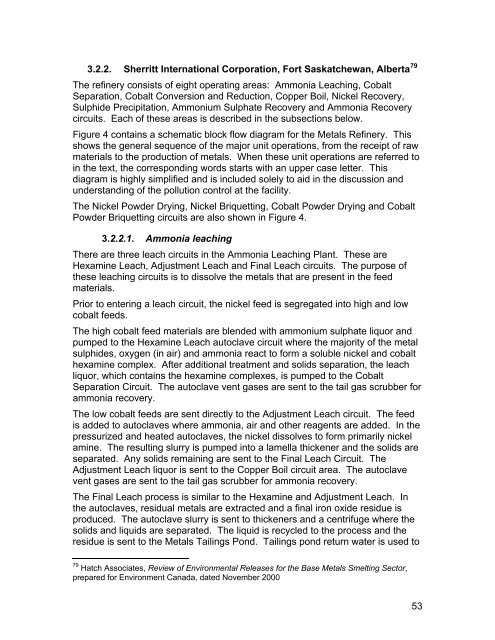(MERAF) for the Base Metals Smelting Sector - CCME
(MERAF) for the Base Metals Smelting Sector - CCME
(MERAF) for the Base Metals Smelting Sector - CCME
Create successful ePaper yourself
Turn your PDF publications into a flip-book with our unique Google optimized e-Paper software.
3.2.2. Sherritt International Corporation, Fort Saskatchewan, Alberta 79<br />
The refinery consists of eight operating areas: Ammonia Leaching, Cobalt<br />
Separation, Cobalt Conversion and Reduction, Copper Boil, Nickel Recovery,<br />
Sulphide Precipitation, Ammonium Sulphate Recovery and Ammonia Recovery<br />
circuits. Each of <strong>the</strong>se areas is described in <strong>the</strong> subsections below.<br />
Figure 4 contains a schematic block flow diagram <strong>for</strong> <strong>the</strong> <strong>Metals</strong> Refinery. This<br />
shows <strong>the</strong> general sequence of <strong>the</strong> major unit operations, from <strong>the</strong> receipt of raw<br />
materials to <strong>the</strong> production of metals. When <strong>the</strong>se unit operations are referred to<br />
in <strong>the</strong> text, <strong>the</strong> corresponding words starts with an upper case letter. This<br />
diagram is highly simplified and is included solely to aid in <strong>the</strong> discussion and<br />
understanding of <strong>the</strong> pollution control at <strong>the</strong> facility.<br />
The Nickel Powder Drying, Nickel Briquetting, Cobalt Powder Drying and Cobalt<br />
Powder Briquetting circuits are also shown in Figure 4.<br />
3.2.2.1. Ammonia leaching<br />
There are three leach circuits in <strong>the</strong> Ammonia Leaching Plant. These are<br />
Hexamine Leach, Adjustment Leach and Final Leach circuits. The purpose of<br />
<strong>the</strong>se leaching circuits is to dissolve <strong>the</strong> metals that are present in <strong>the</strong> feed<br />
materials.<br />
Prior to entering a leach circuit, <strong>the</strong> nickel feed is segregated into high and low<br />
cobalt feeds.<br />
The high cobalt feed materials are blended with ammonium sulphate liquor and<br />
pumped to <strong>the</strong> Hexamine Leach autoclave circuit where <strong>the</strong> majority of <strong>the</strong> metal<br />
sulphides, oxygen (in air) and ammonia react to <strong>for</strong>m a soluble nickel and cobalt<br />
hexamine complex. After additional treatment and solids separation, <strong>the</strong> leach<br />
liquor, which contains <strong>the</strong> hexamine complexes, is pumped to <strong>the</strong> Cobalt<br />
Separation Circuit. The autoclave vent gases are sent to <strong>the</strong> tail gas scrubber <strong>for</strong><br />
ammonia recovery.<br />
The low cobalt feeds are sent directly to <strong>the</strong> Adjustment Leach circuit. The feed<br />
is added to autoclaves where ammonia, air and o<strong>the</strong>r reagents are added. In <strong>the</strong><br />
pressurized and heated autoclaves, <strong>the</strong> nickel dissolves to <strong>for</strong>m primarily nickel<br />
amine. The resulting slurry is pumped into a lamella thickener and <strong>the</strong> solids are<br />
separated. Any solids remaining are sent to <strong>the</strong> Final Leach Circuit. The<br />
Adjustment Leach liquor is sent to <strong>the</strong> Copper Boil circuit area. The autoclave<br />
vent gases are sent to <strong>the</strong> tail gas scrubber <strong>for</strong> ammonia recovery.<br />
The Final Leach process is similar to <strong>the</strong> Hexamine and Adjustment Leach. In<br />
<strong>the</strong> autoclaves, residual metals are extracted and a final iron oxide residue is<br />
produced. The autoclave slurry is sent to thickeners and a centrifuge where <strong>the</strong><br />
solids and liquids are separated. The liquid is recycled to <strong>the</strong> process and <strong>the</strong><br />
residue is sent to <strong>the</strong> <strong>Metals</strong> Tailings Pond. Tailings pond return water is used to<br />
79 Hatch Associates, Review of Environmental Releases <strong>for</strong> <strong>the</strong> <strong>Base</strong> <strong>Metals</strong> <strong>Smelting</strong> <strong>Sector</strong>,<br />
prepared <strong>for</strong> Environment Canada, dated November 2000<br />
53
















